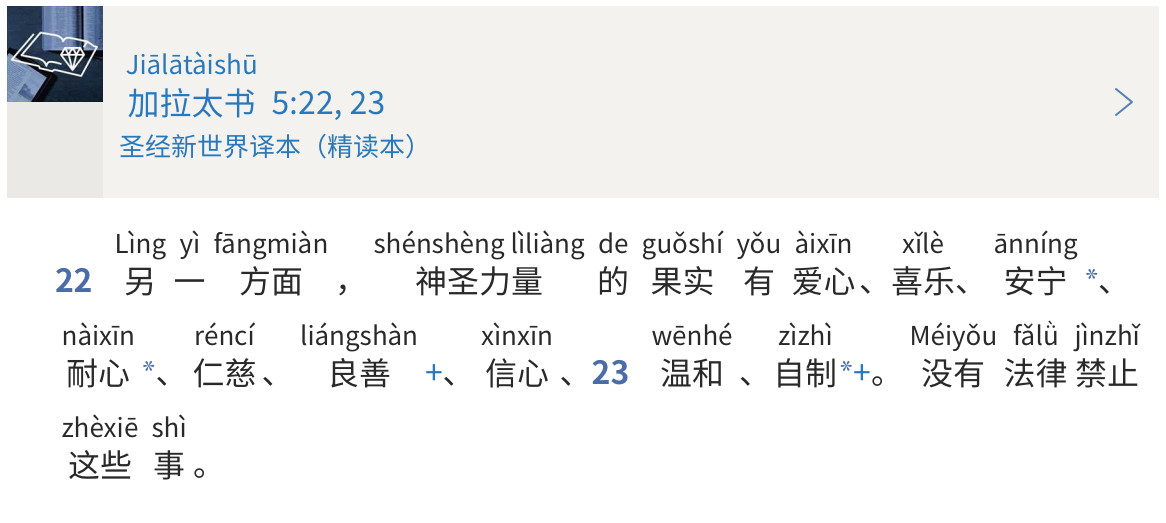zìzhì (zì·zhì self-·{controlling → [control]} 自制) ← Tap/click to show/hide the “flashcard”
The ninth and final part of the fruitage of the spirit listed is self-control.— Jiālātàishū (Jiālātài·shū Galatia · Book → [Galatians] 加拉太书 加拉太書) 5:22, 23.

The English word “self-control” is translated into Mandarin in the above scripture as “zìzhì (zì·zhì self-·{controlling → [control]} 自制)”, this week’s MEotW.
Literally a Verb, Effectively a Noun
Note that in “zìzhì (zì·zhì self-·{controlling → [control]} 自制)”, “zhì ({work out}; formulate; stipulate | restrict; control; govern | system; institution; -ism 制)” is effectively used to mean the noun “control”, even though in this context its literal meaning is actually the verb “controlling”. This seems to be a case of “zhì ({work out}; formulate; stipulate | restrict; control; govern | system; institution; -ism 制)” acting as a verbal noun, or gerundial noun. Verbal/gerundial nouns were discussed in the MEotW post on “jiàodǎo (jiào·dǎo teaching · {guiding [→ [instructing]]} 教导 教導)”:
One interesting thing to note about “jiàodǎo (jiào·dǎo teaching · {guiding [→ [instructing]]} 教导 教導)” (and about “jiàoxun (teaching → [reprimanding | knowledge gained from an error] 教训 教訓)”, for that matter) is that their component morphemes seem to basically be verbs. In certain contexts, however, they are used as nouns. An example of this being done in English is that “teach” and “teaching” are verbs (e.g. “Jesus was teaching the crowd.”), but in certain contexts, “teaching” is used as a noun (e.g. “The crowd was amazed at the teaching Jesus shared with them.”). When a word is used this way, it’s called a verbal noun, or a gerundial noun. Verbal nouns are quite common in Mandarin.
Over-Simplified But Still Extaordinarily Complex?
The character “制”, used to write the “zhì ({work out}; formulate; stipulate | restrict; control; govern | system; institution; -ism 制)” in “zìzhì (zì·zhì self-·{controlling → [control]} 自制)” in both simplfied and traditional characters, is an interesting example of the different compromises involved in those two different writing systems.
If one looks up the simplified character “制” in a dictionary, one may see possible meanings as varied as “restrict; control; govern”, and “make; manufacture”. It turns out that this is because the simplified character “制” can correspond to the traditional character “制”, which can mean “restrict; control; govern”, and it can also correspond to the traditional character “製”, which means “make; manufacture”.
While using the single simplified character “制” to correspond to both “制” and “製” results in not requiring people to learn and remember the relatively complex traditional character “製”, it also results in the simplified character “制” getting “overloaded” (a term that’s used in computer programming) with multiple meanings, which in turn can result in greater ambiguity. At the same time, the simplified character “制” is still a character—it’s still significantly more complex and hard to learn and remember than an alphabetic represention would be. In comparison, the traditional characters “制” and “製” offer reduced ambiguity and can perhaps be said to work better as characters, but at the obvious cost of even greater complexity.
Too Many Words That Sound the Same?
Those invested in characters may point out that even simplified characters are often less ambiguous than Pīnyīn (Pīn·yīn {Piecing Together} · Sounds → [Pinyin] 拼音), which renders “制”, “製”, and also every other character pronounced “zhì” as just “zhì”. The great advantage of Pīnyīn (Pīn·yīn {Piecing Together} · Sounds → [Pinyin] 拼音), though, is its elegant simplicity and significantly greater ease of learning and remembering compared to any character writing system.
It is indeed unfortunate that Pīnyīn (Pīn·yīn {Piecing Together} · Sounds → [Pinyin] 拼音) has inherited a spoken Mandarin language that has come to have many homophones in it, probably from centuries of inappropriate cultural reliance on characters that are seen to disambiguate speech that is heard, instead of just making sure that the speech itself is not riddled with homophones. Even so, the truth is that today homophones are no more a problem in Pīnyīn (Pīn·yīn {Piecing Together} · Sounds → [Pinyin] 拼音) than they are in spoken Mandarin, which people speak to each other all the time without having problems with homophones. How do Mandarin speech and the Pīnyīn (Pīn·yīn {Piecing Together} · Sounds → [Pinyin] 拼音) that simply and directly represents it accomplish this? “Content is king, but context is God.”
(For a more in-depth discussion about homophones in Mandarin and whether they really make Pīnyīn (Pīn·yīn {Piecing Together} · Sounds → [Pinyin] 拼音) unworkable as a writing system for Mandarin, see the subheading “But There Are So Many Words That Sound the Same!” in the article “Pīnyīn (Pīn·yīn {Piecing Together} · Sounds → [Pinyin] 拼音) Was Plan A”.)